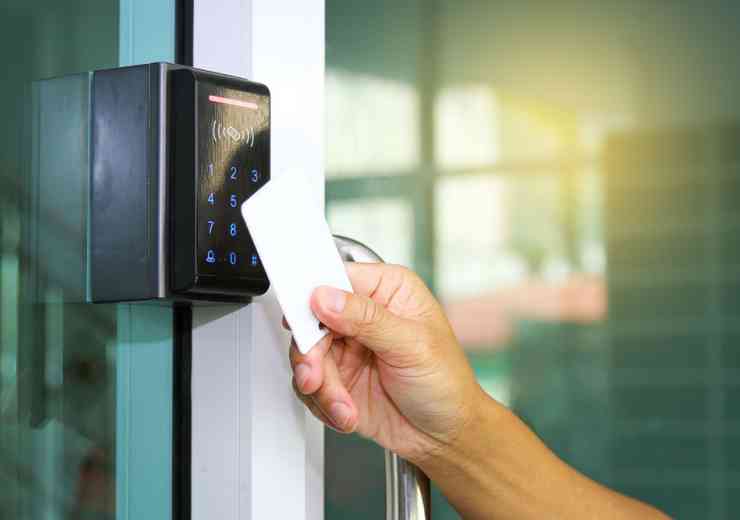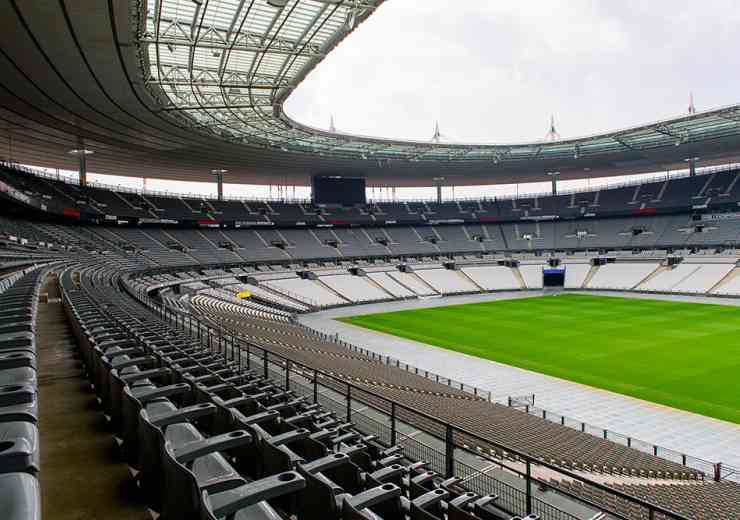Protecting a crowded place
 Crowded places are more often than not busy due to a one-off event taking place, encouraging more people to the area. This calls for the requirement for both manned and electronic security measures.
Crowded places are more often than not busy due to a one-off event taking place, encouraging more people to the area. This calls for the requirement for both manned and electronic security measures.
CCTV
Electronic security such as CCTV and access control have a range of applications, and play a crucial part in the maintenance of order and safety at events, as do the practical application and involvement of security personnel. Officers’ duties can range from crowd management, operation of electronic security systems such as CCTV and access control, car park attendance and general monitoring duties. They also provide that all-important physical presence on the day, becoming a useful port of call for members of the public requiring assistance or information.
With ticketed as well as non-ticketed events expected to draw in considerable crowds, effective crowd management planning in particular is a paramount concern for organisers of both the main events or the many parallel events which often take place alongside them. With large gatherings, in fact, the risk of incidents occurring such as theft, violence and vandalism increases, as do health and safety breaches such as irreparable damage to infrastructure or overcrowding. Personnel who have been trained as crowd safety officers with an NVQ Level 2 in Spectator Safety cover the important role of securing against these threats, by controlling the crowd and, assisted by security operatives, deterring criminals from their intent.
As well as the presence of security equipment and personnel, CCTV can be a valuable asset in helping to control crowds and deter bad behaviour. By using CCTV, police and event stewards are able to have a third eye, as it enables the best possible situational awareness so those in the control room, command vehicle or on the ground, can see the bigger picture of what is happening. This wider view, with CCTV footage linked to a digital map of the vicinity, ensures that officers and event stewards can be marshaled effectively. At a tactical level, operators can drill down to obtain more detail on a specific incident as it develops so that extra resources can be brought to bear and, if necessary, potential troublemakers identified and dealt with. An additional trend is to provide officers with smart phone and tablet technology so they can access and feedback situational-critical information.
Looking in more detail at the type of solutions now being employed around major events, one capability that stands out are command vehicles which offer a high visibility presence. Being mobile and typically featuring multiple CCTV cameras, including a mast-mounted unit, they provide a good all round view and can be moved to specific hotspots. Examples of this are at large scale events such as football games. Rival fans tend to cross or adjacent to public houses in the vicinity of a stadium. Experience has shown that careful positioning of a vehicle, in conjunction with a small number of officers, can effectively maintain a large crowd’s dynamics by moving or splitting sections of fans so preventing dangerous bottlenecks and clashes from developing.
Temporary and mobile solutions
Alongside vehicles, other rapidly deployable forms of CCTV are also becoming a frequent sight at events, especially those which are temporary in nature such as music festivals. Self-contained mobile CCTV towers can be towed to site and set up on the perimeter and at key areas to monitor and control access. Another approach to surveillance is the use of ANPR (Automatic Number Plate Recognition) cameras at the entrance to events to flag up the vehicles of individuals who have a history of anti-social or criminal behaviour.
More recently, BSIA member companies have been focusing their efforts on how the police can utilise smart phone and tablet technology to further enhance the operational capabilities of video surveillance solutions where crowd management and control is a pivotal requirement. In one solution that is being rolled out the police can use their Blackberry phones and tablets to both view and record video footage while they are in the midst of the action. Crucially, should an incident suddenly kick off they can call up what is happening on their phone so they are not necessarily always relying on someone in the control room verbally relaying what is going on, which can take time. In addition, from a recording perspective, by using the in-built camera on their device they can take a snapshot or record an incident as it happens. A major step forward here is the ability to ensure that this evidence can be given sufficient weight in court. Being connected back to the security management platform means there is a time and date stamp associated with the video so it can be logged as an incident in the same way as footage caught on a CCTV camera would be.
Body worn cameras
Another development which is gaining traction is the adoption of body worn cameras. Whilst historically having the right infrastructure and bandwidth has been an issue for the widespread adoption of these systems, the good news is that this is now being overcome as models are being brought to market that are able to stream video and audio content over advanced next generation IP radio networks.
Close protection requirements
It is not just crowds that require particular security attention. As was the case for the London 2012 Olympic and Paralympic Games, a large concentration of high-profile individuals were in attendance, including national and international politicians, celebrities, members of the Royal family and well‑known sport personalities. Close protection detail therefore needed to be in place.
Mike O’Neill, Chairman of the BSIA’s Specialist Services Section, comments: “There was a commonly-held perception that the Metropolitan Police were to provide Close Protection services to visiting dignitaries at the Games, but police close protection resources were already allocated early on, meaning that many visitors needed to appoint a private company to provide Close Protection during the Olympic celebrations.
“A good working knowledge of the area’s geography, its culture and the impact of the events taking place are all essential requirements for effective close protection,” Mike continues.
“Equally important is a close protection officer’s ability to adapt their approach depending on the individuals under protection; for example, an individual travelling with young children or family will have much more complex requirements than a person travelling alone.”
The close protection officer’s work starts before an event, with the in depth scrutiny of the venue to ensure all angles are covered. In most scenarios, officers must ensure that high profile attendees are able to go about their daily business with almost an invisible bubble around them, reacting only when required.
Common Wealth Games
Police Scotland will be working with a number of security suppliers to deliver a safe and secure Commonwealth Games in Glasgow this summer.
The private security suppliers will work as part of what Glasgow 2014 terms an ‘integrated, multi-agency approach’ under the leadership of Police Scotland and working alongside military personnel, British Transport Police and officers from the Scottish Prison Service.
David Leather, Chief Operating Officer at Glasgow 2014, comments: “Glasgow 2014 has been working positively and collaboratively with Police Scotland and the private security industry to develop security and stewarding solutions which will play a key role in delivering a safe and secure Commonwealth Games in less than two months’ time.
“We recognise and value the important role private security suppliers have to play and we are delighted to have created the opportunity for a wide range of security providers to contribute to delivering a safe and enjoyable Games experience for athletes, officials and spectators under the guidance of Police Scotland.
“Glasgow 2014 is the biggest multi‑sport event Scotland has ever hosted, it will be a special time and we want people to enjoy their experience as much as possible. We are confident that the approach being taken regarding both security and safety stewarding will play a positive role in the delivery of a safe and secure Games we can all be proud of.”
Guarding
Security officers and patrols by foot or by vehicle cover a range of crucial functions in securing crowded areas at all times: during busy periods such as events, rush hour, shopping centres, it is crucial guards are constantly patrolling the area and are present at all times.
When deployed, officers deal with many issues that enable police or community support officers to free up their time to deal with more serious crimes. From manning access points, escorting trespassers off sites and dealing with substance abuse to traffic and parking management for functions and events, the presence of security officers is crucial in securing a crowded environment. They also can often responsible for managing technological aspects of a site’s security solutions, such as CCTV or access control.
Feedback from end-users reveals that security staff are not only employing security systems effectively but doing so in a way that exceeds their remit. So-called ‘added-value’ services are regularly featured in customer reports of this kind and appears to be driven by the high levels of team spirit and ‘ownership’ of the site’s interests arising from the close working relationships that develop between security teams and the site’s everyday users. In one sense, added value could be described simply as an inevitable element of a security team working conscientiously to discharge its responsibilities but it often goes far beyond that. The willingness of security officers to voluntarily put themselves forward for work that would normally be done by in‑house employees is a recurring theme. Bearing in mind that security often assumes duties that other employees would otherwise have to be employed to carry out – reception staff for example – they are a highly cost-effective way of making the best use of technology and filling the gaps left by police budget cuts.
It is important that when securing crowded areas, all elements of security should be taken into consideration.
FURTHER INFORMATION
www.bsia.co.uk
digital issue



















